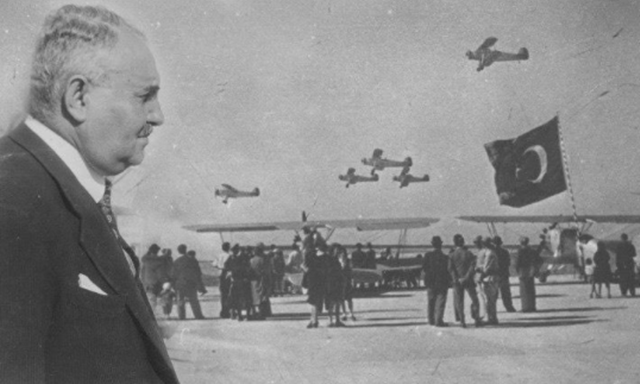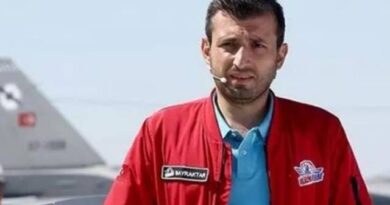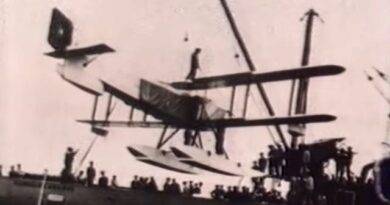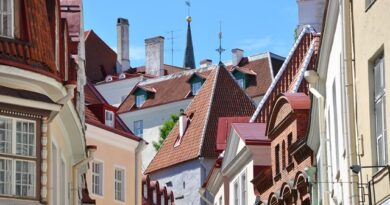Who is Nuri Demirağ?
Aviation history is full of successful business people. Especially in the early periods when aviation developed, every country needed entrepreneurs and aviation enthusiasts. In this article, we will talk about a person who is very important to the Republic of Turkey. Nuri Demirağ, let’s take a closer look at the life of this entrepreneur and philanthropist.
Nuri Demirağ is known as a businessman who brought many firsts to Turkey, and he is one of the first contractors of railway constructions. Because of his contributions in this field, the surname was given to Nuri Demirağ by Mustafa Kemal Atatürk. “Demirağ” means railway in Turkish.
Nuri Demirağ realized the firsts such as the establishment of the first aircraft factory in Turkey, the first cigarette paper production, the first domestic parachute production. In addition to these, he was the first person to bring up the idea of building a bridge over the Bosphorus and a big dam to Keban/Elazığ/Turkey. He is especially remembered for his achievements in the aviation industry. At the same time, Nuri Demirağ is the founder of the National Development Party, the first opposition party of the Republic of Turkey.
Nuri Demirağ was born in 1886 in the Divriği district of Sivas, Turkey. His father was Mühürzade Ömer Bey and his mother was Ayşe Hanım. Nuri lost his father when he was three years old and was raised by his mother.
After completing his secondary education in Divriği High School, Nuri Demirağ worked in his own school for a while as an assistant teacher due to his success at school. He passed the civil service exam opened by Ziraat Bank in 1903 and was appointed to the branch in Kangal village of Sivas, and a year later he appointed to the Koçgiri Branch. Between 1906 and 1909, there was a famine in Erzurum province. And Nuri Demirağ, using his personal initiative, sold the wheat and grains left in the warehouses to the public at a reasonable price. That’s why he was investigated and later cleared.
Nuri Demirağ passed the exam of the Ministry of Finance in 1910 and became a finance officer. He was appointed to Istanbul as a civil servant in the Beyoğlu Revenue Department. After a short time, he became the Property Manager of Hasköy, Istanbul. He worked at all levels of finance. On the other hand, he completed his higher education by attending night classes at the School of Finance. He became a finance inspector in 1918. He resigned after a while while he was working in Beyoğlu and Galata.
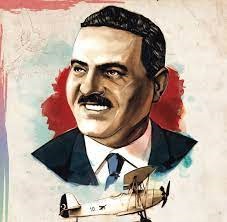
source: sivas governorate
The First Turkish Cigarette Paper
Nuri Demirağ, after leaving the Finance Inspectorate, looked for ways to do business. In 1918, he chose the foreign-dominated cigarette paper business and invested in it. He started the first Turkish cigarette paper production in a small shop in Eminönü, Istanbul. He named the cigarette paper he produced as “Turkish Victory”. In those years, there was a war of Independence. Turkish Victory cigarette papers attracted great attention by the Turkish people. Nuri made great profits from this first venture.
Turkish War of Independence Period
Mrs. Mehmet Nuri, while dealing with cigarette paper production and trade in Istanbul during the Turkish War of Independence, also managed the Istanbul, Maçka Branch of the Defense of the Law Society.
Railway Construction
The Turkish War of Independence was over and the Republic of Turkey was established. The young Turkish Republic was oriented towards the problems of the country. To solve the transportation problem, priority was given to the development of the railway network. The French company, which undertook the construction of the Samsun-Sivas railway in 1926, left the business. Nuri Demirağ received the tender for the seven-kilometer section to be built in the first place. He then took on the rest of the business. His brother Abdurrahman Naci Bey also resigned from his job as an engineer in the Land Registry Office and became the partner of Nuri Demirağ. Nuri Demirağ had now become the first railway contractor of the Republic of Turkey. Working with his brother, he completed the Samsun-Erzurum, Sivas-Erzurum and Afyon-Dinar line, the 1012-kilometer railway in a short period of one year. The area they built was a very mountainous and rocky terrain. However, Mrs. Nuri and Mrs. Abdurrahman completed the work on time. Because of these achievements, Mustafa Kemal Atatürk gave himself and his brother Abdurrahman Naci the surname “Demirağ” in 1934.
Nuri Demirağ – Construction works
Mrs. Nuri started various major construction projects while the railway was being built. Karabük Demir Çelik built the İzmit Cellulose, Sivas Cement and Bursa Merinos facilities, the Eceabat Airport, and the Istanbul Market Hall on the edge of the Golden Horn.
Bosphorus Bridge Project
Nuri Bey started the project to build a bridge across the Bosphorus in 1931. He brought experts from abroad and had them examined; He hired the company that built the Golden Gate to build a bridge on the same system as the Golden Gate Bridge in San Francisco. He presented the project, all preparations of which were completed, to the President Atatürk in 1934. Although the project was liked by President Atatürk, the project did not receive approval from the government and the project did not materialize. This situation created a great disappointment in Nuri Demirağ.
Nuri Demirağ – Political Life
Nuri Demirağ entered politics. In 1945 he founded Turkey’s first opposition party, the National Development Party. The party could not enter the parliament in the 1946 and 1950 elections. Nuri Bey put his candidacy from the Democratic Party in the 1954 elections and became a Sivas deputy. He worked on regression in desertification, agriculture, pioneering, energy, dams, bridges and ports.
Nuri Demirağ – Aircraft factory and sky school
The following words of Mrs. Nuri about aviation and aircraft industry are very important. “Getting licenses from Europe and America and making airplanes is just copying. License is given for outdated types. The newly invented ones are kept like a secret, with great jealousy. Therefore, if one continues with copying, time will be wasted with outmoded things. In that case, a brand new Turkish type should be built in response to the latest system airplanes from Europe and America.”
Nuri Demirağ, on of the richest businessman of the time, began his attempt to establish the state’s first aircraft factory in 1936. In those years, the army’s need for aircraft was met with donations collected from the public and wealthy businessmen. When asked to participate in a fundraiser to buy airplanes, he said, “If you want something from me for this nation, you have to ask for the best. Since a nation cannot live without an airplane, then we should not expect this means of life from the grace of others. I aspire to build the factory of these planes.” He replied with his words.
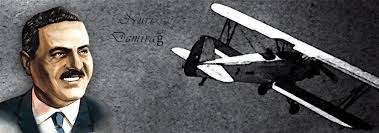
source: sivas governorate
Nuri Demirağ had planned to establish the factory in his hometown, Divriği, Sivas. However, first of all, a trial workshop was to be established in Istanbul. For this purpose, he agreed with a Czechoslovak company. A workshop building was built next to the Barbaros Hayrettin Pasha Pier in Istanbul. He bought Elmaspaşa Farm in Yeşilköy and built a runways, hangars and aircraft repair workshop on it in order to make test flights. The area was the size of Amsterdam Airport, which was the largest airport in Europe at that time. This area is used as the International Istanbul Atatürk Airport today.
It was necessary to establish an aviation school in order to train Turkish pilots who would use the planes. The Sky School was established on the land where the runway is located. The school trained 290 pilots until 1943. Before the Sky School in Yeşilköy, he opened a Sky Secondary School in Divriği. In this school, which was opened when there was no secondary school in any district of Sivas, all the expenses of the students are covered; Students were brought to Istanbul to aspire to aviation and flying lessons were given.
Selahattin Reşit Alan, one of Turkey’s first aircraft engineers, drew the plan for the aircraft and gliders to be produced at the aircraft factory in Beşiktaş, Istanbul. In 1936 the first single-engine airplane was produced and the aircraft was named Nu.D-36. In 1938, a twin-engine 6-seater passenger plane, Nu.D-38, was built. The NuD-38 was included in the A class of world aviation passenger aircraft in 1944. The first aircraft order was given by the Turkish Aeronautical Association (THK) in 1938.
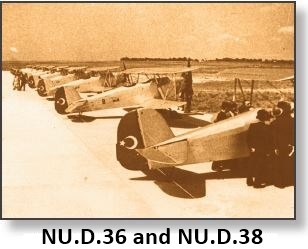
Nuri Demirağ continued his work in aviation by producing Turkey’s first domestic parachute in 1939. In 1941, the first fully Turkish-made aircraft flew from Istanbul to Divriği. Galip Demirağ, the son of Nuri Demirağ and one of the first graduates of the Sky School, was the pilot on this flight.
After 65 gliders ordered by THK were delivered in a short time; 24 training aircraft, named NuD-36, were completed and test flights were carried out in Istanbul.
Closing of aircraft factory
A test flight was requested once again in Eskişehir for the delivery of the aircraft, which was ordered by THK and finally flew from Istanbul to Eskişehir. Selahatin Reşit Alan, while landing with his Nu.D-36 aircraft in 1938, did not see the ditch opened on the runway so that the animals around would not enter the airport and fell into the ditch. Reşit Alan died in this accident. After this accident, THK canceled the order. Nuri Demirağ took the THK to court after this incident. There was a court process with THK that took years. The court concluded in favor of THK. In addition, a law was enacted to prevent the planes from being sold abroad. Therefore, the factory, which could not receive orders, was closed in the 1950s. The runways, hangars, all the built buildings on them for the flight test tests of the airplanes produced in Beşiktaş and the sky school, all the established facilities that were the size of the world’s largest airport in those years, Amsterdam Airport were expropriated. This airport is today’s Atatürk Airport.
Orders from Spain, Iran and Iraq are blocked; The remaining aircraft were sold to scrap dealers. After losing the case, Nuri Demirağ’s attempts to correct the mistake by writing letters to the members of the government and the president were unsuccessful; The factory could not be reopened.
He died on 13 November 1957 in Istanbul due to diabetes. He was buried in Zincirlikuyu Cemetery.
Source:
http://www.sivas.gov.tr/nuri-demirag
https://istanbultarihi.ist/578-the-nuri-demirag-aircraft-factory
